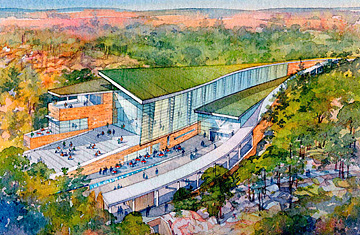
The proposed American Revolution Center.
Joyce Cluley has all the usual concerns about the proposed development down the street from her house — traffic, noise, environmental damage — plus one more: dishonoring the men who made America independent.
Cluley is a leader of local opposition to the proposed American Revolution Center, a 300,000-square-foot museum and conference center, which will include restaurants and up to 99 hotel rooms. What makes it so controversial is that this particular development is set to be built on a privately owned 78-acre parcel nestled inside the Valley Forge National Historical Park, famed as the site where the fragile Continental Army set up camp and survived the dark winter of 1777-78. Cluley is adamant about her cause. Without the soldiers who used this property during the Revolution, she says, "There would be no United States... They're going to pave over history. That's why I am fighting this."
The non-profit center aims to be the nation's first museum dedicated to the complete story of the Revolution. Backers say it will not only preserve and interpret important artifacts from the period, but will create more than 800 jobs, draw 725,000 history-minded visitors annually, and solidify the region's historic claim to be the cradle of American independence. "Our purpose is to reengage the American public in the history of the American Revolution and its relevance to today, because the American Revolution is still in progress," says Thomas M. Daly, president of the center, which grew out of the century-old Valley Forge Historical Society. "We have this significant deficit in the understanding of our founding principles. These freedoms we have didn't just fall out of the sky."
However, vigorous opposition from preservationists and some local residents greeted the local planning commission's preliminary approval of the project in May. The focus of their ire is the plan to develop a parcel of property in the park known as the Pawlings Farm. Some historians believe it was the location of a major supply depot used to collect cattle and other food coming to the beleaguered American army from farms up north. Critics and preservationists say the expansive development will permanently alter historically important land and set a dangerous precedent for other National Parks, many of which have similar small private parcels tucked in and around the boundaries. The Lower Providence Township Board of Supervisors will now consider giving final approval at a public hearing June 23.
"People see a national park and say 'Oh, this is protected.' Well, not completely," says Joy Oakes, senior Mid-Atlantic regional director for The National Parks Conservation Association, "because within those boundaries are holes... and all it takes is one bad development, or one perfectly good development in the wrong place, to have an enormous impact."
This patchwork of public and private land can lead to development within the parks themselves. In 2004, only a last-minute offer of $8.5 million from the federal government stopped a developer from building a 62-acre luxury subdivision in another part of the Valley Forge park. In 2005, the National Park Service was unable to buy a 20-acre site inside Zion National Park and the owners have subsequently turned it into a private spiritual retreat center. And Gettysburg, not too far from Valley Forge, remains among the nation's most threatened historical sites. With roughly 20% of the battlefield in private hands, preservationists are in a constant battle to block private development inside the park.
Protecting historically important sites is more than academic, says historian Wayne Bodle, a professor at Indiana University of Pennsylvania who helped identify the Pawlings Farm site as historically significant in the late 1970s. "Actually seeing the terrain and getting a sense of what it looks like does make a difference," he says. If historical sites are developed, "you could still reconstruct the narrative... but it would be pretty disorienting to try to explain it to people."
There was little contentiousness in the beginning. The $100 million project began with nearly universal support from historians, lawmakers, and area residents more than a decade ago. Congress authorized the Revolution Center to build its facility adjacent to the current National Park Service Visitors Center at Valley Forge. But relations soured between the National Park Service and the Revolution Center, which said the Park Service was limiting the scale of the museum and demanding too much control. In 2006, center officials broke off negotiations with the Park Service and found the privately owned Pawling Farm site inside the park. The Park Service too had been eyeing the site but had never been able to come up with the money.
The Revolution Center says the development will enhance, not destroy, the historic character of the site, which is in a relatively remote corner of the park and currently attracts very few tourists. Where Valley Forge today attracts many recreational users, Daly says, there was a time when travelers came on a "pilgrimage to the nation's shrine." "We think we can help to restore Valley Forge to the iconic place that it once was in our nation's mind," he said.
